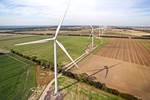Vestas selected to supply turbines for offshore wind project
Vestas will supply 138 V236-15.0 MW turbines for Empire Offshore Wind’s 2.1 GW offshore wind projects, which are located 15-30 miles off the coast of Long Island, New York, U.S.
(Aarhus, Denmark) has been named as the preferred turbine supplier for , a joint venture between (Stavanger, Norway) and (London, U.K.). Vestas will supply 138 V236-15.0 megawatt (MW) turbines for the 2.1 gigawatt (GW) Empire Wind 1 and Empire Wind 2 offshore wind projects, located 15-30 miles off the coast of Long Island, N.Y., U.S.
With this project, New York, Equinor, BP and Vestas together are said to be bringing the country closer to achieving the current president’s goal of 30 GW of offshore wind capacity installed by 2030, as well as New York’s goal of installing 9 GW of offshore wind capacity by 2035.
The tower sections for Empire Wind 1 and 2 are planned to be sourced from the Marmen/Welcon plant, which is being developed in Port of Albany. For staging of turbine components, Vestas will use the upgraded port at South Brooklyn Marine Terminal, developing a New York-based supply chain to provide a comprehensive set of services in the staging, pre-assembly and installation activities. Vestas currently has more than 1,000 suppliers in the U.S. that support its onshore business.
In addition, Vestas says it will deliver a comprehensive multi-year solution to service the wind farm when operational, with the goal to establish a New York-based service organization providing local employment opportunities.
Vestas plans to disclose the order in a company announcement in accordance with the company’s disclosure policy — if and when the agreement with Empire materializes in a firm order for the company.
Related Content
-
ZEBRA project demonstrates closed-loop wind recycling system
Consortium partners have proven the complete recycling of thermoplastic wind turbines via two manufactured wind blades, featuring reduced operating cost, CO2 emissions.
-
Honda begins production of 2025 CR-V e:FCEV with Type 4 hydrogen tanks in U.S.
Model includes new technologies produced at Performance Manufacturing Center (PMC) in Marysville, Ohio, which is part of Honda hydrogen business strategy that includes Class 8 trucks.
-
Infinite Composites: Type V tanks for space, hydrogen, automotive and more
After a decade of proving its linerless, weight-saving composite tanks with NASA and more than 30 aerospace companies, this CryoSphere pioneer is scaling for growth in commercial space and sustainable transportation on Earth.






